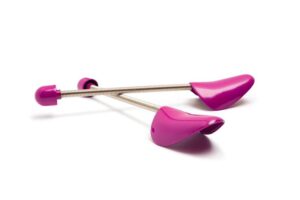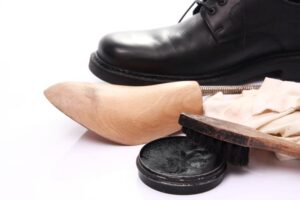While spiral shoe trees are often favored by many, they may not be the ideal solution for preserving the quality and shape of your footwear. Your shoes represent a valuable investment, and utilizing inappropriate shoe trees can result in irreversible damage. Although these spring-loaded devices seem convenient, they exert harmful vertical pressure that can distort the upper leather and undermine the heel stiffener. In contrast, opting for high-quality wooden shoe trees provides gentle horizontal support, effectively maintaining your shoes’ original shape while significantly prolonging their lifespan. Making this simple adjustment to your shoe care routine can be vital in preserving your cherished footwear for many years.
Recognizing the Dangers of Using Spiral Shoe Trees
To adequately protect your shoes, it is crucial to understand the potential hazards associated with spiral shoe trees. These commonly used shoe care tools, present in 80% of households that employ shoe trees, can inadvertently compromise your footwear’s structure and shape over time. By being aware of these risks, you can make better-informed choices regarding your shoe maintenance and ensure that your investment remains intact.
Spotting the Design Limitations of Spiral Shoe Trees
A staggering 90% of spiral shoe trees are designed with a “one size fits all” approach, which results in poor fit and inadequate support for your shoes. This generic design fails to accommodate the unique shape and size of your footwear, making them ineffective at preserving the shoe’s proper form. The lack of customization in these shoe trees can ultimately lead to unnecessary wear and tear, shortening the life of your beloved shoes.

Understanding the Negative Impact of Pressure Points
The use of spiral shoe trees poses a significant risk of creating harmful pressure points within your shoes. The metal spring exerts upward force against the vamp area, while the small rear component applies concentrated pressure on the heel stiffener. This uneven distribution of force can lead to a multitude of significant issues that compromise the integrity of your footwear.
Furthermore, prolonged reliance on spiral shoe trees can cause permanent deformation of your shoes. The persistent vertical pressure can damage the welt stitching, causing the leather to bulge and ultimately altering its original shape. You may begin to notice these detrimental changes as soon as three to six months of regular use have passed.
The Compromised Structure of Shoes with Spiral Shoe Trees
Using spiral shoe trees can inflict serious damage to your shoes’ structural integrity. The uneven pressure distribution and continuous strain caused by the spring mechanism can lead to permanent deformation, negatively impacting both the upper leather and the internal support systems of your shoes.
Assessing Deterioration in the Vamp Area
The effects on the vamp area are particularly concerning, as spiral shoe trees unnaturally push the upper leather upwards. This vertical force can distort the original shape of your shoes and potentially damage the welt stitching, leading to premature wear and increasing the risk of sole separation. Such issues can significantly reduce the overall lifespan of your footwear.
Investigating Damage to the Heel Stiffener
Behind the scenes, the heel stiffener experiences concentrated pressure from the small tail piece of spiral shoe trees. This pressure can cause the heel area to bulge, especially in shoes with leather or leather board stiffeners, ultimately altering the original heel shape. This alteration not only affects the aesthetics of your shoes but also their overall functionality.
Additionally, damage to the heel stiffener can often be irreversible. Continuous pressure from spiral shoe trees can lead to deformation of up to 50% more than its original shape, as evidenced in documented cases involving RM Williams boots. Such deformation not only diminishes comfort but also significantly reduces the lifespan of your shoes, leading to unsatisfactory performance and increased replacement costs.
Clearing Up Common Misconceptions About Shoe Care
Despite their widespread use, spiral shoe trees can indeed cause serious damage to your footwear. Many people believe that these devices help maintain shoe shape, but in reality, they frequently create harmful pressure points, leading to permanent distortion of the leather over time.
Disproving the One Size Fits All Fallacy
One of the most significant mistakes you can make is assuming that generic spiral shoe trees will fit all your shoes correctly. These products typically come in just one or two standard sizes, rendering them incapable of providing the tailored support your shoes require. This universal approach can lead to uneven pressure distribution and potential damage that could have been easily avoided with a more customized solution.
Weighing Price Against Quality in Shoe Trees
Just because a product fits within your budget does not mean it will fit your shoes properly. While spiral shoe trees may present an affordable option, their lower price often indicates substandard design and the potential to cause up to 70% more damage to your footwear compared to properly sized wooden shoe trees.
When assessing costs, it is vital to consider long-term expenses. Utilizing spiral shoe trees can reduce your shoes’ lifespan by 40%, ultimately requiring more frequent replacements. Although quality wooden shoe trees might necessitate a higher initial investment, they offer superior shape retention and play a crucial role in preserving the original form of your footwear over time.

Defining the Essential Characteristics of Quality Shoe Trees
Many shoe trees available today fail to provide adequate support for your footwear. Your ideal shoe tree should feature anatomically correct shapes that align with your shoe’s natural form. It’s essential to invest in separate left and right trees, with proper width adjustability and designs that maintain your shoe’s original shape without exerting excessive pressure.
Emphasizing the Importance of Horizontal Stretch Properties
Your shoe tree should facilitate a gentle horizontal stretch between the toe and heel regions, rather than applying vertical pressure. It is vital for the tree to evenly distribute the width of your shoes, effectively preventing creases while preserving the leather’s natural shape. This horizontal force is crucial for maintaining the vamp area without compromising the welt stitching.
Ensuring Balanced Volume Distribution in Shoe Trees
The design of your shoe tree should prioritize even volume distribution throughout your shoe. Proper support must be provided in the toe box while also ensuring gentle pressure along the sides. The heel area requires careful support without excessive force, as this could jeopardize the heel stiffener and alter your shoe’s original shape.
Effective pressure distribution is a fundamental aspect of shoe tree functionality. Your shoe trees should fill 80% of your shoe’s volume while avoiding concentrated pressure points. This balanced approach aids in moisture absorption and shape maintenance without risking damage to the leather or structural elements of your shoes.
Discovering Suitable Alternatives for Effective Shoe Care
To achieve optimal shoe maintenance, you must explore reliable alternatives to spiral shoe trees that will protect your footwear’s shape and extend its lifespan. The right shoe tree should distribute pressure evenly while providing natural support that does not damage the leather or stitching.
Top Shoe Tree Types for Maximum Protection
- Cedar wood shoe trees – naturally absorb moisture and prevent unpleasant odors
- Split-toe designs – offer adjustable width for a superior fit
- Full heel support – ensures proper back shape maintenance
- Anatomically correct forms – designed specifically for left and right shoes
| Feature | Benefit |
|---|---|
| Cedar Material | Absorbs moisture and prevents unpleasant odors |
| Split-toe Design | Offers customizable width adjustment for a better fit |
| Full Heel Block | Maintains the integrity of the heel shape |
| Anatomical Shape | Preserves the natural form of your shoes |
| Even Pressure | Helps prevent any distortion of the leather |
Best Practices for Proper Shoe Tree Usage
When inserting shoe trees, it is advisable to do so immediately after wearing your shoes while they are still warm. This practice helps maintain the original shape as the leather cools and prevents unwanted creasing. Ensuring the shoe trees fit appropriately is crucial; avoid applying excessive pressure. Keep them in for at least 24 hours after use to allow ample time for moisture evaporation and shape retention. The shoe trees should occupy the shoe volume naturally, without stretching or distorting the leather in any way.
Investing Wisely in Your Shoe Care Routine
Having understood the dangers posed by spiral shoe trees, it’s time to focus on making informed investments in your shoe care practices. Quality shoe trees can protect footwear worth hundreds or even thousands of dollars, making them an indispensable part of your shoe care routine. The choice of shoe trees significantly impacts the longevity and durability of your shoes.
Focusing on Long-term Shoe Care Strategies
Contrary to common belief, spiral shoe trees can harm your expensive footwear by creating unwanted pressure points. Investing in durable wooden shoe trees that distribute pressure evenly across the shoe will help maintain its original shape and extend its lifespan by several years, ensuring that your investment remains worthwhile.
Evaluating Cost-Benefit Analysis for Shoe Tree Purchases
The long-term savings associated with using proper shoe trees far outweigh their initial purchase cost. While spiral shoe trees might be priced between $10-15, quality wooden shoe trees costing $30-50 can save you hundreds of dollars in shoe damage. Investing in the right shoe trees is an effective way to safeguard your footwear investment and avoid costly repairs.
While the temptation to save money with cheaper spiral alternatives may be strong, consider this: proper wooden shoe trees can prevent heel distortion, maintain leather integrity, and preserve shoe structure. By investing wisely, you’ll ultimately spend less on shoe repairs and replacements over time. The numbers are clear – investing in quality shoe trees now will save you money on shoe replacements in the future.

Essential Insights for Effective Shoe Care
In summary, it is imperative to avoid spiral shoe trees due to their potential to harm your shoes through inappropriate pressure distribution and inadequate design. Instead, investing in high-quality wooden shoe trees tailored to your shoe size and shape is essential for maintaining the integrity of your footwear. These trees will protect your shoes by offering horizontal support, ensuring they retain their original shape. Opt for cedar or beech wood shoe trees with adjustable width and appropriate toe shapes. This straightforward change in your shoe care routine can significantly enhance the preservation of your shoes’ structure and prolong their lifespan.
Your Questions Answered: Shoe Tree FAQs
What makes spiral shoe trees harmful to my shoes?
Spiral shoe trees threaten the well-being of your shoes primarily due to two factors. They push the leather upwards at the vamp area, leading to damage to the shoe’s shape and potential harm to the welt stitching. The small back component also applies excessive pressure to the heel stiffener, which may result in permanent deformation in that area. These complications occur because spiral shoe trees exert pressure in incorrect directions, unlike proper shoe trees that function horizontally.
Which type of shoe trees should I consider instead of spiral variants?
Choose solid wooden shoe trees that feature an anatomical shape specifically designed to match your shoe size. Quality shoe trees should include a full heel piece instead of just a small tail section and should stretch the shoes horizontally rather than vertically. They must fill the shoe’s volume uniformly without exerting excessive pressure on any specific area. Split-toe designs are particularly effective, as they allow for adjustable width for a better fit.
If spiral shoe trees are my only option, what should I do?
If spiral shoe trees are your only choice, consider using them without bending the spring (keeping the back part out) or refrain from using shoe trees at all. Forgoing shoe trees is less harmful than improperly using spiral ones. The best course of action is to invest in proper wooden shoe trees, which will aid in maintaining your shoes’ shape and prolonging their lifespan.
The Article Why you should avoid using spiral shoe trees and what to use instead appeared first on My Shoes Finder
The Article Avoid Spiral Shoe Trees: Discover Better Alternatives Was Found On https://limitsofstrategy.com

I found your insights on the dangers of spiral shoe trees particularly enlightening. It’s fascinating how something so seemingly simple can impact our beloved footwear. I’ve always thought that a shoe tree was a shoe tree, but it turns out the specifics really matter when it comes to preserving quality. A while back, I invested in a pair of good leather shoes that turned out to be quite the splurge for me, and at first, I used spiral shoe trees without a second thought. After a few months, I started noticing some odd creases that I just couldn’t explain. It makes me wonder how many people unknowingly contribute to the wear and tear of their shoes without realizing it.
It’s interesting to hear about your experience with spiral shoe trees. Many people might not connect those little details to the larger picture of shoe care, and it’s easy to overlook how something as simple as a shoe tree can influence the condition of a quality pair of leather shoes.